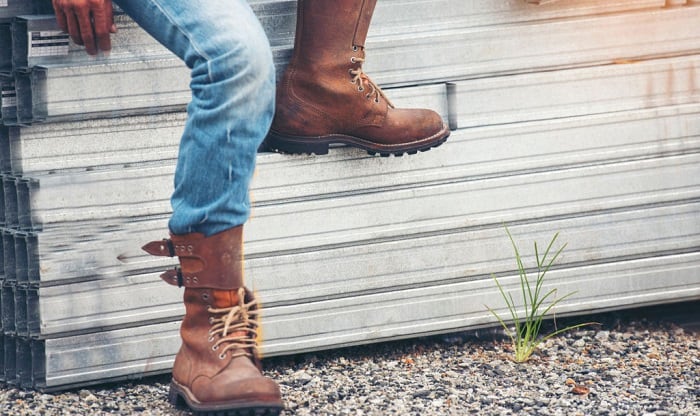Have you ever found yourself complaining after a day’s work that your toes are hurting? It is probably because your work boots are reinforced with steel toe caps.
Many employees in a risk-prone workplace such as a construction site choose steel toe work boots as their protective footwear because they are cheap and of good quality. But wearing boots for long hours can be discomforting.
This shouldn’t stop you from using them because there is something you can do to address the issue, so how to make steel toe boots comfortable? Scroll down and learn how.
Table of Contents
Steps to Make Steel Toe Boots Comfortable
Let’s say you already have safety steel toe boots and after using them several times, you noticed that your toes began to hurt. Do you throw them away? Do you buy new ones? Possibly, but it will cost you another hundred bucks and it isn’t practical, especially if your pair of steel boots is still very functional.
Whether the discomfort or strain on your feet is because your safety footwear is too big or too tight, before you decide to ditch it, try the recommended steps below to make steel toe boots more comfortable to wear.
Step 1: Cut the insoles.
This is the first step in addressing the issues of discomfort or pain from using a work boot. It might be that the insole is occupying too much space in the toe box. Gradually cut the toe side of the insole until you get the perfect fit for your feet.
Step 2: Insert full-cushion insole.
If your pair of boots is a bit bigger, you might need additional insoles. Just insert the full insole on top of the shoe insole. This will provide another layer of support and pressure relief to your toes, allowing them to fit and rest comfortably.
Step 3: Insert ball-of-foot cushion.
This ball of foot pad addresses the issue of pain in your ball of the foot. Place the cushioning in the forefront of the boot; this will provide your toes with an added level of comfort since the extra weight is transferred to the ball-of-foot pad.
Step 4: Try different socks.
Put on a different pair of socks and see what kind of socks give you the most comfort. The added value when you wear thick socks is that they tend to be more secure since the thick cloth of the socks provides a better layer of toe protection and prevents your toes from rubbing the steel wall.
Step 5: Stretch your shoes.
Stretching your shoes is an effective way of giving them an additional length and width for at least half an inch. This method can give your feet more room to adjust and extra space for your toes, giving them overall comfort while using protective shoes.
Step 6: Apply some rub relief.
Applying a rub relief or any relief oil to your toes can protect them from irritation, soreness or blisters as a result of constant abrasion of your toes and the steel wall. A rub relief is like a lubricant that when applied, minimizes the friction between your toes’ skin and the protective footwear’s steel toe tips.
Pro Tips
Make sure to follow the steps mentioned above to address the discomfort and pain you experienced and to make toe boots more comfortable while using them at work and during longer periods.
Below are some pro suggestions you can follow to ensure that your toes won’t hurt anymore:
- Make sure the safety steel boots fit perfectly. When choosing a safety shoe, make sure that the shape and size are perfect for your feet. Try it on first, walk around the store, feel the fit, and watch out for some pain. Only pay for it once you’re very sure.
- Always look for a pair of steel-toed shoes with good arch support. Good arch support is when the contours of your feet perfectly match with the insole of the shoes. You’ll know if the arch support is good when there is no pain.
- A laced steel toe shoe is a good choice if you want to feel comfortable with your protective shoe. You can pull your feet to the back of the boot, giving your toes more room in the toe box while the lace keeps your feet in their proper place.
Why Wearing Steel Toe Boots Is Hurting Your Toes
Why does this piece of protective equipment that’s supposed to keep you safe hurt you? What are the factors that can contribute to the discomfort you feel? Read below to find out.
Possible Reasons Why Your Toes Are Hurting
- The primary reason why a steel-toed boot is hurting your toes is that the toe cap in your shoe is made from steel. Steel is a hard material, and when it consistently hits your toes, it hurts them and can cause blisters.
- Compared to other safety toes, boots with steel caps are extra heavy because of the steel material reinforced in the toe area.
- There are instances where the toe box is narrow, giving your toes less room to breathe and move, thus straining them.
- The reason your boots sting could be because the shoe is either too small or too big for your feet.
- The protective footgear you have has low arch support, and this could give you pain and discomfort.
- Another reason why steel-toe boots are uncomfortable is that you are not using them with the right socks.
The discomfort and pain you feel from sporting steel toe boots should not be neglected, or else it will lead to a more serious foot and toe problem.
Possible Toe Injuries From Wearing Steel-Toed Boots
- Blisters – this could happen if you wear a steel-toed shoe that is very tight. Tight boots could result in excessive rubbing of your toes to the steel walls of the toe area, leading to blisters or soreness.
- Callus – calluses occur when the skin on your toes thickened or hardened due to the pressure you exert on your toes against the steel-toed tips.
- Corn – this injury is similar to calluses, but it tends to be a bit smaller and round. Corn can usually be seen on the top and side of your toes & caused by excessive friction.
- Crossover Toe – this condition is usually a result of a small and tight toe box. Crossover toe occurs when the second or third toe crosses over to the top of the next toe.
- Hammer Toe – hammer toe takes place when your toes start to bend, causing the bony part to rub against the wall of the steel toe.
- Ingrown toenail – this happens when you don’t cut your toenails properly and one of your toes is pressed hard against another in a shoe that’s too small.
Safety steel toe boots are very important to ensure your body’s defense as soon as you start clocking in at your workplace where there are possibilities of accidents from falling objects that are heavy or sharp.
But when your source of safety becomes your source of distress, then you should do something about it. And this is why this article is created, to help you find ways to have more comfortable steel toe boots.
To relieve the soreness in your toes and other areas in your feet from wearing uncomfortable boots, check this video.
Conclusion
You deserve to wear good quality steel-toed shoes. They should be worn not only to protect you and your feet from getting injured but should also give you the ease and confidence to walk around and do your job, knowing that you are comfortable in good steel toe boots.
This article is your how-to guide in wearing a steel toe boot comfortably. Let us know what you think in the comment section and share this article to help more people learn how to make steel toe boots comfortable!

This is Edward Manning, the editor in chief of Construction Informer. Quite a bit of my time is spent researching the market and interviewing experts in the field so that I can give you reliable information.




